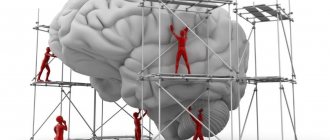People by nature tend to live in harmony with themselves, their worldview, beliefs, principles, philosophy. This is what allows us to feel whole and satisfied. But often in our everyday life we can encounter such a phenomenon when some contradictory ideas, reactions, values, ideas collide with each other in our minds. This is where we talk about the state of cognitive dissonance.
Despite the periodic appearance of this phenomenon in the lives of each of us, few people wonder what it really is. Many people often use this phrase in a completely different meaning, without delving into its essence and true definition. Nevertheless, every person needs to have basic psychological knowledge, because this will help him to better know, first of all, himself. And our online program “Cognitive Science” will help you look more rationally at emerging problems and find non-standard approaches in difficult life situations, where in 2 months you will learn more than 20 thinking techniques and ways of their practical application.
So, what is cognitive dissonance and how does it manifest itself in our lives?
A little about the history of the concept
The category “cognitive dissonance” comes from two Latin words – “cognitio”, meaning “cognition” and “dissonanita”, meaning “lack of harmony”, and is a special condition during which a person feels mental discomfort caused by a clash of contradictory things in his mind. each other's beliefs, ideas, reactions regarding some phenomenon or object. To explain the concept of “cognitive dissonance” in simple words, it is an unpleasant feeling caused by a contradiction between reality and your ideas about it.
The theory of cognitive dissonance was first proposed by the American psychologist Leon Festinger in 1957. Based on two other theories - Kurt Lewin's field theory and Fritz Heider's theory of structural balance - Festinger developed a psychological concept that explains conflict situations in the cognitive sphere of the individual caused by events, phenomena or actions of other people.
The reason for the creation of the concept was the spread of rumors about an earthquake in India in 1934. Residents of regions that were not affected by the earthquake began to widely claim the impending danger of new, even stronger tremors of the earth's surface. The scientist was surprised by such unfounded and pessimistic predictions, and based on the results of the study, it was discovered that in fact the residents of these regions justified their anxiety, fear and anxiety in this way.
Festinger's theory of cognitive dissonance has been questioned by some modern experts. For example, the famous popularizer of evidence-based psychology, Pavel Zygmantovich, points out that cognitive dissonance is associated with conflicting ideas, opposing cognitions (ideas) about oneself, and not about the world around us, emphasizing the too broad scope of Festinger’s theory of cognitive dissonance.
However, returning to the original model, it is worth mentioning two hypotheses put forward by the scientist:
- In a state of cognitive dissonance, a person will invariably strive to eliminate the inconsistencies that caused it. This is influenced mainly by the state of psychological discomfort accompanying dissonance.
- To neutralize this discomfort, a person will strive to avoid situations that may aggravate it.
Now let's pay attention to why this phenomenon appears and how it manifests itself.
[edit] Hardware level
It is worth highlighting separately the situation when new information contradicts not so much accumulated experience as the architecture of the human brain in principle. As a rule, it is not caused by information coming from outside, but by the results of strong thoughts, when the brain produces a response that it itself is not able to perceive, which makes this phenomenon similar to division by zero and gives the right to consider it a bug in human development.
At-risk groups:
- matan adherents who recreate n-dimensional spaces in their minds (where n can even be infinity);
- philosophers searching for the meaning of existence;
- physicists developing theories for the construction of space-time;
- a special risk group is any person above 150 who is trying to understand infinity.
Awareness of such concepts, for which the human mind is not initially adapted, leads to the fact that the patient with a high degree of probability flies into the atral and, with an even greater probability, never returns from there. However, basic motor skills are retained (walking, eating, defending doctoral dissertations), which often makes it impossible to immediately identify victims and send them for treatment.
Causes and examples of cognitive dissonance
Cognitive dissonance can occur due to various circumstances:
- Any situation from the present does not correspond to the experience from the past. For example, if you see a group of fire rescuers entirely made up of women, you will probably be surprised, because our usual consciousness says that fire rescue is, to a greater extent, a male profession.
- One person's opinion goes against the opinions of others. If you believe that keeping money in a bank is unsafe and unprofitable, taking it on credit is complete bondage, if in principle you never use the services of a bank, you will sincerely not understand why other people buy banking products.
- Traditions and customs of other peoples that are unfamiliar to people. For example, in China the color of mourning is white, and if you accidentally find yourself at a funeral ceremony in China, you may be taken aback to see that everything around you is white.
- Logical inconsistency of any facts. A person who finds himself in St. Petersburg for the first time in the summer and does not know about the white nights may find himself discouraged on the first evening, because we are all accustomed to the timely end of the day and the beginning of the night.
As another example, we can give the following situation: you are standing on the street and see two people - a respectable man and a tramp. You have your own idea about each of them: a respectable man seems to be an intelligent, well-mannered, gentleman, and a tramp is rather his complete opposite. But then a nice man’s phone rings, he answers the call and starts talking loudly, using a lot of obscene language, spitting on the sidewalk and completely not paying attention to those around him. At the same time, the tramp comes up to you and, in a tone worthy of a real intelligent person, asks you what time it is and how he can get to such and such an address. At a minimum, you will be surprised and discouraged by this state of affairs - opposing ideas and beliefs have just collided in your mind. These are all examples of cognitive dissonance.
[edit] See also
- Buthurt
- Wash your brain
- Schizophasia
- What were you smoking?
- Division by zero
- Break pattern
- I don't understand shit
- Mutually exclusive paragraphs
| [ + ] Cognitive dissonance - material from the archives of the Ministry of Health of Lurkomor. | |||||||||||||||
| |||||||||||||||
How to counteract cognitive dissonance?
The impact of cognitive dissonance is often underestimated, when in fact it is very serious. As already mentioned, this condition itself arises when a person’s knowledge does not correspond. Therefore, in order to make a decision, a person sometimes has to set aside what he knows and do something differently, which in turn creates a discrepancy between what he thinks and what he does. The result of this is a change in attitudes, which is simply necessary and inevitable for a person’s knowledge to be consistent. Thus, the first way to deal with cognitive dissonance is to change your way of thinking, change your attitudes.
An example situation: if you are male and you decide to choose the profession of a stylist, but deep down you recognize this profession as “not too masculine,” you will have to change your attitudes and admit that a man with a traditional orientation can engage in this type of work.
Cognitive dissonance, depending on the situation, tends to become stronger or weaker. The intensity of the state of dissonance directly depends on the importance of the choice facing the person. In addition, any fact of dissonance motivates a person to eliminate it. This is what serves as a catalyst for the fact that many people often justify some of their actions, thoughts, mistakes and actions, changing their beliefs to please them, because this neutralizes intrapersonal conflict. Accordingly, excuses are the second method of overcoming cognitive dissonance.
Another example: a person strives to acquire an athletic physique. It’s beautiful, pleasant, makes you feel good, and your health will be stronger. To achieve the goal, he must start working out, go to the gym, go to training regularly, eat right, follow a routine, etc. However, all this requires physical effort, willpower, discipline, strong desire, etc., but not everyone is able to comply with these conditions. Therefore, you can find many reasons why a person will not do this: no time or money, (supposedly) poor health, and anyway, the physique is, in principle, normal. Thus, any actions of a person will be aimed at reducing dissonance - getting rid of contradictions within himself.
But the appearance of cognitive dissonance can be avoided. Most often, this is helped by simply ignoring any information regarding the problem, which may differ from the existing one.
Imagine: when faced with any difficult situation, you simply begin to deny it, “turn on” the child and do not want to see reality. For example, you have an important exam coming up, but you don’t want to prepare for it at all. In this case, it is very convenient to think that “it will pass by itself somehow” or “someone will help me”, or “I passed it before and now I’ll pass it somehow”... It turns out that you need to find information that will “justify” existing thoughts or behavior, and try to avoid the opposite. But often this strategy leads to fear of dissonance, prejudice, personality disorders and even neuroses.
Does this mean that cognitive dissonance is something to be afraid of?
Real life examples
Cognitive Dissonance
Examples caused by a contradiction between acquired knowledge and reality.
Cognitive dissonance can also arise in the parental family. For example, dad often whiles away the evenings drinking a bottle of beer and this is perceived as normal by all family members. The father's behavior is not condemned and does not entail any negative consequences for him.
A teenager, growing up in such a family, buys himself beer and starts drinking it. But he immediately gets a slap on the head from his parents. The child cannot compare cause and effect, does not understand what bad he has done: after all, his dad does the same all the time.
Another example.
The girl is raised to be friendly, submissive, and friendly. Arriving at school, she encounters aggression, rudeness and cynicism. An understanding comes that intelligence and friendliness are not an unconditional norm of behavior for other people.
Why does modern man lie so often?
Cases when concepts and knowledge contradict each other
The woman has two fans with whom she communicates closely.
One of them is a young guy, a student, with whom she is interested and pleasant to spend time. However, the young man has no housing and no funds. The other is a man 20 years older, who does not evoke emotions or feelings, but is reliable and wealthy. If both boyfriends propose, the girl will have a painful choice between her feelings and a promising future. The case when both options carry both positive and negative consequences, in any case, something will have to be sacrificed.
Another example
. A man is offered a highly paid job abroad. But, firstly, he is not very interested in her, and secondly, he will have to live separately from his family for some time.
I want to earn money and solve family problems: pay off debts, pay off the mortgage. It's scary to leave your existing job, which you enjoy and brings satisfaction. It is scary to go far from your family, because there is a risk that the marriage will not withstand such a test, there is a possibility of cheating far from each other.
Important!
In case of a difficult choice, it is advisable to focus on your primary needs and those principles that are basic for the individual. If a person understands what he is not ready to give up under any circumstances, the negative consequences of one of the options will be minimized.
Rigid person - Who is this? Rigidity - What is it in Psychology?
There is no escape from this...
In order not to perceive cognitive dissonance painfully, you just need to accept the fact that this phenomenon occurs at all. It is important to understand that the discrepancy between some elements of a person’s belief system and the actual state of affairs will always be reflected in life. In fact, it is much easier to accept the facts as they are and try to adapt to the circumstances, without wasting your energy on thoughts that perhaps something was done wrong, some decision was made incorrectly. If something has already happened, then so be it.
In one of the books of the famous writer Carlos Castaneda, in which he describes the process of his training with an Indian shaman, his teacher tells him about one very effective way to live - to be a Warrior. Here it is not worth going into details of the philosophy of this path, but you just need to say that one of its main features is that a person can doubt and think until the moment he makes a decision. But, having made his choice, he must throw away all his doubts and thoughts, do what is necessary, and calmly accept the result, whatever it may be.
As for the worldview as a whole, the state of cognitive dissonance most often arises only because we are firmly convinced that something should be exactly this way and no other way. Many people believe that their opinion is the only correct one, that only the way they think is correct, everything should be the way they want. This position is the least effective for a harmonious and happy life.
Finally, accept that things may be completely different from your thoughts, views, and beliefs. The world is full of not just different people and facts, but also all sorts of mysteries and unusual phenomena. And our task is to learn to look at it from different angles, taking into account any possibilities, and not to be “narrow-minded”, stubborn and fixated on ourselves and our knowledge. Cognitive dissonance is a condition that is inherent, to varying degrees, in every person. It is important to know about it, to be able to identify and eliminate it. But it is equally important to take it for granted.
We wish you success!
What is your opinion on this issue? Surely, when reading the article, you remembered several interesting examples of cognitive dissonance from your personal life. Tell us about your experience, because nothing generates such interest as real stories. In addition, many will be interested in reading about how someone else comes out of this state. So we are waiting for your stories and comments.










